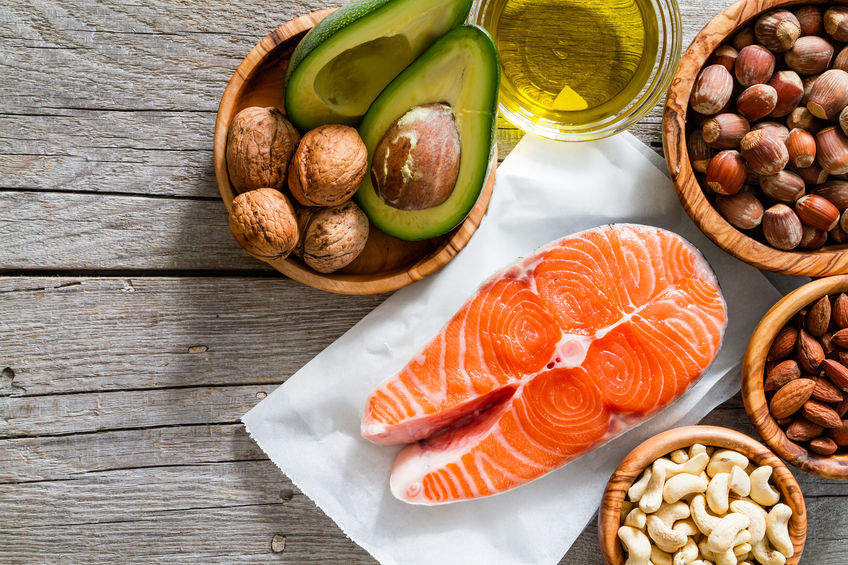
Beware of Healthy Fats
“Healthy” fats aren’t really that healthy if consumed in excess. They are still fat and too much fat in your diet isn’t necessarily healthy for anyone. Maintaining a healthy diet can sometimes be a challenge, especially in the fast-paced world we live in. Trying to find time to do healthy meal planning is sometimes the lowest priority in our daily lives after family, work, exercise, and hopefully some time just to relax. And the food industry realizes this, too.
Eating healthy always was, and always will be, a balance of carbohydrates, proteins, and fats. Yes, we’ve been taught that we should have a balanced diet of grains (carbs/fiber), fruits (carbs/fiber), vegetables (fiber/carbs), meat (protein/fat) and dairy (protein/fat), but when it comes down to it, our body looks at food in three categories – carbs, proteins, and fats. And whatever the latest fad might tell you, a healthy eating plan should be a BALANCE of all three. Let’s look at the three categories and figure out just what each one does for your body.
Carbohydrates are the foods that give our bodies energy. Once ingested, our body converts the carbs we eat into sugar for our body to use as energy. Just as a person with Type 1 diabetes counts carbohydrates to calculate their insulin injection, your body uses insulin to convert those carbs to energy. Some of that sugar can also be stored in our body as glycogen in the liver and muscles. If you don’t get enough carbs, your body will be lacking in energy and will look to your liver and muscles for that stored glycogen for the energy needed to survive. And, when glucose from carbohydrates is lacking, muscle can also be broken down into amino acids and converted into glucose or other compounds to generate energy. This is not good for your muscle mass, nor is it good for your body.
Proteins provide your body with very essential nutrients that are responsible for growth, development, helps your immune system, regulates various processes in your body, and many other vital tasks. But too much protein can also be bad for you. Protein is an essential part of a healthy diet. It helps to build and repair muscle, organs, and bones. High-protein diets have also been shown to be helpful with reducing fat, losing weight, increasing satiety, or a feeling of fullness, and retaining muscle.
However, high-protein diets have also been associated with several risks that are important to be aware of and understand. Nutritional experts don’t advocate consumption to exceed the recommended daily amount.
Fats are essential to your body, also. They give us energy, support cell growth, protect your organs, and keep your body warm. Fats help your body absorb some nutrients and produce important hormones, too. Fats help your body absorb some nutrients and produce important hormones, too. Your body definitely needs fat.
There are four different types of fat: Saturated, Trans, Monounsaturated, and Polyunsaturated.
The four types have different chemical structures and physical properties. The bad fats, saturated and trans fats, tend to be more solid at room temperature (like a stick of butter), while monounsaturated and polyunsaturated fats tend to be more liquid (like liquid vegetable oil).
Fats can also have different effects on the cholesterol levels in your body. The bad fats, saturated fats, and trans fats raise bad cholesterol (LDL) levels in your blood. Monounsaturated fats and polyunsaturated fats can lower bad cholesterol levels and are beneficial when consumed as part of a healthy dietary pattern.
But all fats add calories to your diet – even the “good” or “healthy” fats. Avocados are high in “healthy” (monounsaturated) fat, along with fiber and other nutrients. But that doesn’t mean your diet should consist of only avocados. Granted, we would all probably enjoy a serving of guacamole with every meal, but that key ingredient – Avocado – with all of its “healthy” characteristics is very high in calories. The recommended serving is 1/3 of an avocado, where the serving size of other fruits and vegetables are to eat 1 – apples, peppers, cucumbers, bananas – all are a 1 serving size – because they are nutritious AND not so high in fat.
So, as you continue to work on balancing your intake of carbs, proteins, and fats, keep in mind what many wise people have said time and time again. Everything in moderation. Just because one type of food is hyped as healthy doesn’t mean you should rely solely on its health benefits for your diet. Keep a good mix of foods that we learned about in grade school that make up a balanced diet and don’t rely too much on one type – your body will thank you.
